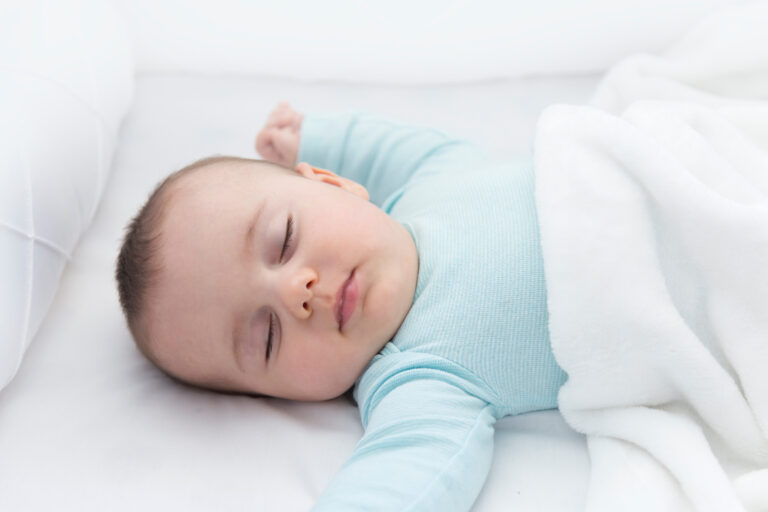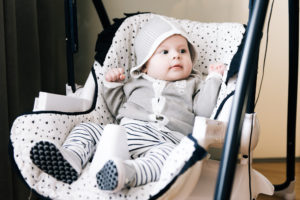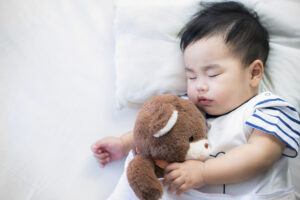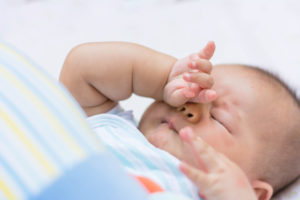When you buy through our links, we may earn a commission. Products or services may be offered by an affiliated entity. Learn more.
18-Month Sleep Regression
Our medical review team has recently evaluated this page to ensure accuracy. We will continue to monitor and revise this article as new literature is published the 18-month sleep regression.
- As babies grow, it can affect their sleep quality and quantity, also known as a sleep regression.
- Sleep regressions can be caused by several factors, including an 18-month old’s increased mobility and awareness.
- Common signs of sleep regression include fussiness, nighttime awakenings, and more daytime naps.
- Improve sleep regression by reinforcing a bedtime routine and sleep schedule and creating a comfortable sleep space.
Sleep is an important factor in the variety of developmental milestones seen in 18-month-olds, including walking and talking. Compared to infants, toddlers usually sleep through the night with more consistency. However, their trend toward improved sleep can hit a snag around 18 months – a point when many toddlers experience a common sleep pattern disruption called a sleep regression.
A sleep regression can mean problems at bedtime or waking up during the night. While ups-and-downs in sleep patterns are normal, they can be challenging for caregivers. In most cases, though, an 18-month sleep regression is short-lived, especially when caregivers maintain healthy sleep habits.
What Is the 18-Month Sleep Regression?
As a child grows physically, mentally, and emotionally, it can affect how much and how soundly they sleep. These notable changes in sleep quality and quantity is referred to as a sleep regression.
At 18 months, a child is well into the toddler stage of development, marked by rapid changes to their physical abilities, cognitive skills, and emotional evolution. Sleep helps power this development, and toddlers need a total of 11 to 14 hours of sleep per day , according to expert recommendations.
This quantity of sleep is usually made up of one nighttime sleep period and one nap during the day. Some 18-month-olds sleep through the night, but individual sleep patterns in very young children can vary significantly .
These differences in sleep from one toddler to another are tied to developmental processes. Typically, 18-month-olds gain mobility while becoming more communicative. Emotional reactions deepen, potentially causing or increasing separation anxiety . Thinking, reasoning, and other cognitive functions also expand considerably during this stage of development.
What Causes an 18-Month Sleep Regression?
While sleep regressions typically do not have one single cause, several factors may be involved:
- Resistance to bedtime, which may be tied to an increased sense of independence or overstimulation in the evening
- Restlessness related to expanded mobility and physical abilities
- Separation anxiety
- Discomfort from teething
- Adaptation to changing sleep schedules or sleep training
- Nightmares, although they are uncommon among 18-month-olds
Do All Children Have an 18-Month Sleep Regression?
Many toddlers do not experience a sleep regression at 18 months. Sleep patterns unfold differently for every child, so toddlers may face problems before or after the 18-month mark. Some 18-month-olds may even show notable improvement in sleep.
For this reason, it is best to understand sleep regressions as phases that can occur during the development of any child but not something that is destined to occur for every child at a specific point in time.
Help Your Baby Sleep Better With Pediatric Sleep Coaching

our partner at sleepdoctor.com
Learn More“Life-changing! My anxiety about my son’s sleeping habits were immediately reduced after talking to Sara. She went above and beyond to tailor a schedule to our goals, answer our questions, keep us on track, and check in to encourage us when we just thought we couldn’t do it anymore.”
Rachael B. – Verified Customer
What Are the Signs of an 18-Month Sleep Regression?
An 18-month sleep regression may present through a variety of symptoms. Some of the most common indicators include:
- Greater resistance to going to bed or fussiness at bedtime
- Inability to relax and fall asleep once in bed
- Increased crying out when caregivers move away from the bed
- Higher instances of nighttime awakenings
- Heightened agitation and more difficulty calming down after waking up in the night
- Longer or more frequent daytime naps
How Long Does an 18-Month Sleep Regression Last?
The symptoms of an 18-month sleep regression rarely last for more than a few weeks. In the same way that their cause may not be clear, sleep regressions may end without an obvious explanation.
The exact timeframe can depend on the toddler, their development, and the underlying issues causing their sleep regression.
Once a child has started sleeping normally again, additional sleep regressions may occur later on. Ups-and-downs are normal, so caregivers should remain prepared for future episodes of sleep troubles. Sticking with routines to develop healthy sleep habits can make it less likely that a child will have future sleep problems .

How Can Caregivers Cope With Sleep Problems in an 18-Month-Old?
There is no cure-all for an 18-month sleep regression. Instead, most experts call for a bigger picture view that ensures that caregivers are promoting positive sleep habits for their toddlers.
While an 18-month sleep regression can be difficult for both caregivers and children, it provides an opportunity to reflect on the child’s sleep hygiene. Cultivating good habits can provide a strong foundation for quality sleep when the child moves past their sleep regression.
There are a number of tips and strategies that can enhance sleep in toddlers .
- Repeat the same bedtime routine: Maintaining a set process to get ready for bed can give your child cues that bedtime is coming and has been shown to improve children’s sleep . The routine should include engaging in soothing activities in soft lighting, making sure your toddler is comfortable, and saying goodnight in a reassuring way to reduce separation anxiety.
- Set a sleep schedule: Building a regular schedule for both nighttime sleep and naps can subtly reinforce a positive sleep pattern.
- Make their sleep space comfortable: Try to keep the area as dark and quiet as possible, free from distractions or disruptions. Some children benefit from a white noise machine to drown out other sounds, and a dim night light can help toddlers who are afraid of the dark.
- Get active during the day: It will be easier for your toddler to sleep at night if they get out their energy during the day. Physical activity is especially beneficial if they get daily exposure to natural light, which can contribute to a healthy circadian rhythm.
These strategies can create a framework for solid sleep, but they may take time for both you and your toddler to get used to. Be patient and understand that better sleep may not happen right away.

Coping With Separation Anxiety
Separation anxiety is a major contributor to sleeping problems in toddlers. It can make them resistant to going to bed, cry out once they are in bed, or fail to get back to sleep if they wake up in the night.
Some separation anxiety is normal, but it is best for caregivers to avoid reinforcing it.
- Encourage self-soothing: Avoid immediately responding when your toddler cries out. Instead, give them an opportunity to calm themselves down before tending to them.
- Avoid co-sleeping: It is best not to bring your child into bed with you. By figuring out how to make your toddler comfortable in their own bed, you can help them feel more independent and secure.
- Prevent sleep disruptions: If you need to comfort your child, do it while preserving the feel of bedtime. This means keeping the lights low, maintaining a quiet environment, and not taking them out of bed.
- Create gradual distance: If your child cries out multiple times, try to soothe them each time from a little farther away.
- Provide comforting accessories: It can be soothing for your toddler to be able to see an item that reminds them of you, or have a favorite toy or stuffed animal near their bed. However, it is important to follow safe sleep guidelines and make sure these items are not choking hazards.
- Practice incremental separation: Do separation trial-runs during the day so that your child gets accustomed to being with other adults and staying calm when you are not by their side.
An adjustment period is normal for children to get over separation anxiety. Focusing on a good process for handling their worries can empower them to self-soothe and sleep well on their own.
Managing Sleep Problems From Teething
Teething is an ongoing process that starts during infancy and can last through the toddler years. Because teething is uncomfortable, it may complicate falling asleep or sleeping through the night. You can offer relief to your toddler by lightly massaging their gums with a damp, cool washcloth, or providing them with a soft teething ring to chew on.
When Should Caregivers Talk With a Doctor About Sleep Problems in an 18-Month-Old?
While sleep regressions can be frustrating, they usually do not last for more than a few weeks. However, if sleeping problems continue for a month or more, you should bring them up with your toddler’s pediatrician. It is also good to check with the doctor if you notice other issues including:
- Significant snoring or abnormal breathing during sleep
- Stunted growth
- Limited weight gain
- Reduced energy or other daytime impairment
- Longer naps during the day
- Significant changes to appetite, bowel habits, or urination
Caregivers and Self-Care
For many caregivers, there is an impulse to put their full attention on their child, but this can mean losing sight of self-care. Keeping yourself healthy, including getting needed sleep, allows you to be a more supportive and attentive caregiver.
Self-care also means remembering that parenting is hard. Some sleep problems are to be expected for toddlers, even for caregivers who do everything in their power to encourage good sleep. As hard as it is, being patient with yourself and your child can help navigate the ups-and-downs of a young child’s sleep.

Still have questions? Ask our community!
Join our Sleep Care Community — a trusted hub of sleep health professionals, product specialists, and people just like you. Whether you need expert sleep advice for your insomnia or you’re searching for the perfect mattress, we’ve got you covered. Get personalized guidance from the experts who know sleep best.
References
9 Sources
-
National Center on Birth Defects and Developmental Disabilities (NCBDDD), Centers for Disease Control and Prevention (CDC). (2022, December 12). Important milestones: Your child by eighteen months., Retrieved May 1, 2023, from
https://www.cdc.gov/ncbddd/actearly/milestones/milestones-18mo.html -
Paruthi, S., Brooks, L. J., D’Ambrosio, C., Hall, W. A., Kotagal, S., Lloyd, R. M., Malow, B. A., Maski, K., Nichols, C., Quan, S. F., Rosen, C. L., Troester, M. M., & Wise, M. S. (2016). Consensus statement of the American Academy of Sleep Medicine on the recommended amount of sleep for healthy children: Methodology and discussion. Journal of Clinical Sleep Medicine, 12(11), 1549–1561.
https://pubmed.ncbi.nlm.nih.gov/27707447/ -
Mindell, J. A., Leichman, E. S., Composto, J., Lee, C., Bhullar, B., & Walters, R. M. (2016). Development of infant and toddler sleep patterns: real-world data from a mobile application. Journal of sleep research, 25(5), 508–516.
https://onlinelibrary.wiley.com/doi/10.1111/jsr.12414 -
A.D.A.M. Medical Encyclopedia. (2022, June 7). Separation anxiety in children. MedlinePlus., Retrieved May 1, 2023, from
https://medlineplus.gov/ency/article/001542.htm -
A.D.A.M. Medical Encyclopedia. (2020, October 2). Teething. MedlinePlus., Retrieved May 1, 2023, from
https://medlineplus.gov/ency/article/002045.htm -
A.D.A.M. Medical Encyclopedia. (2020, October 2). Bedtime habits for infants and children. MedlinePlus., Retrieved May 1, 2023, from
https://medlineplus.gov/ency/article/002392.htm -
American Academy of Pediatrics (AAP). (2022, August 30). Getting Your Baby to Sleep., Retrieved May 1, 2023, from
https://www.healthychildren.org/English/ages-stages/baby/sleep/Pages/Getting-Your-Baby-to-Sleep.aspx -
Mindell, J. A., Li, A. M., Sadeh, A., Kwon, R., & Goh, D. Y. (2015). Bedtime routines for young children: A dose-dependent association with sleep outcomes. Sleep, 38(5), 717–722.
https://pubmed.ncbi.nlm.nih.gov/25325483/ -
American Academy of Pediatrics (AAP). (2013, September 15). Sleeping Through the Night., Retrieved May 1, 2023, from
https://www.healthychildren.org/English/ages-stages/baby/sleep/Pages/Sleeping-Through-the-Night.aspx




























